Towards Efficiently Provisioning 5G Core Network Slice Based on Resource and Topology Attributes
Abstract
:1. Introduction
- We propose a network node scoring and ranking method by jointly considering local and global network resource and topology attributes. Specifically, we introduce a cooperative provisioning coefficient for the physical node scoring to enhance the efficiency of provisioning slice links.
- We design a two-stage 5G core slice provisioning algorithm, called RT-CSP, which includes a heuristic slice node provisioning algorithm and a k-shortest path based slice link provisioning algorithm. In the first stage, slice nodes are provisioned in a heuristic manner in accordance with the network node ranking results. In the second stage, the k-shortest path algorithm is used to provision slice links.
- To further improve the performance of RT-CSP, we propose RT-CSP+ slice provisioning algorithm based on our designed minMaxBWUtilHops strategy in the slice link provisioning stage. The strategy selects the physical path which has the minimum product of the maximum link bandwidth utilization and its hop count from the candidate physical paths obtained by the k-shortest path algorithm to host the slice link.
- We verify the performance of our proposed algorithm through extensive simulations and prove that our algorithm can increase the slice request acceptance ratio and, hence, the revenue of physical network provider.
2. Related Work
2.1. VNE Methods
2.2. Resource Allocation in Network Slicing
3. Problem Description and System Model
3.1. 5G Core Slice Provisioning Problem Description
- The topology of the slice remains unchanged during the life cycle of the slice, which means slice reconfiguration is not considered here.
- Slice nodes from the same 5G core network slice request can only be mapped to different physical nodes, that is, co-hosting is not allowed [28].
- Slice links cannot be split. They can only be hosted by one physical path [28].
3.2. System Model
3.2.1. 5G Core Infrastructure
3.2.2. 5G Core Slice Request
3.2.3. Slice Provisioning Process
3.2.4. Performance Metrics
4. Heuristic 5G Core Network Slice Provisioning Algorithm Design
4.1. Node Ranking Based on Network Resource Attributes and Topology Attributes
4.1.1. Local Resource Attributes
4.1.2. Global Resource Attributes
4.1.3. Degree Centrality
4.1.4. Closeness Centrality
4.1.5. Node Ranking Strategy
4.2. Heuristic Slice Provisioning
4.2.1. Slice Node Provisioning
| Algorithm 1 Slice node provisioning based on network resource and topology attributes. |
|
4.2.2. Slice Link Provisioning
| Algorithm 2 Slice link provisioning based on minMaxBWUtilHops. |
|
4.2.3. Slice Provisioning
4.2.4. Time Complexity of RT-CSP+ Algorithm
| Algorithm 3 Slice provisioning algorithm RT-CSP. |
|
5. Performance Evaluation
5.1. Evaluation Settings
5.2. Evaluation Results and Analysis
5.2.1. Experiments in the Scenario where the Slice Request Arrival Rate Is Four Requests Per 100 Time Units
5.2.2. Experiments in the Different Slice Link Connected Probability Scenario
5.2.3. Experiments in the Different Slice Request Arrival Rates Scenario
5.2.4. Experiments in The Different Sizes of Substrate Network Scenario
6. Conclusions
Author Contributions
Funding
Conflicts of Interest
References
- Amendola, C.; Calabrese, M.; Caputo, F.; Fabrizio, D. Fashion companies and customer satisfaction: A relation mediated by Information and Communication Technologies. J. Retail. Consum. Serv. 2018, 43, 251–257. [Google Scholar] [CrossRef]
- Del Giudice, M.; Caputo, F.; Evangelista, F. How are decision systems changing? The contribution of social media to the management of decisional liquefaction. J. Decis. Syst. 2016, 25, 214–226. [Google Scholar] [CrossRef]
- Stone, D.L.; Deadrick, D.L.; Lukaszewski, K.M.; Johnson, R. The influence of technology on the future of human resource management. Hum. Resour. Manag. Rev. 2015, 25, 216–231. [Google Scholar] [CrossRef]
- Susskind, R.E.; Susskind, D. The Future of the Professions: How Technology Will Transform the Work of Human Experts; Oxford University Press: New York, NY, USA, 2015. [Google Scholar]
- Papagiannis, H. Augmented Human: How Technology Is Shaping The New Reality; O’Reilly Media, Inc.: Farnham, UK, 2017. [Google Scholar]
- Selin, C. The Ethics of Invention Technology and the Human Future. Science 2016, 353, 756. [Google Scholar] [CrossRef]
- Johnson, D.G. Technology with no human responsibility? J. Bus. Ethics 2015, 127, 707–715. [Google Scholar] [CrossRef]
- Rost, P.; Banchs, A.; Berberana, I.; Breitbach, M.; Doll, M.; Droste, H.; Mannweiler, C.; Puente, M.A.; Samdanis, K.; Sayadi, B. Mobile network architecture evolution toward 5G. IEEE Commun. Mag. 2016, 54, 84–91. [Google Scholar] [CrossRef]
- Jain, R.; Paul, S. Network virtualization and software defined networking for cloud computing: A survey. IEEE Commun. Mag. 2013, 51, 24–31. [Google Scholar] [CrossRef]
- NGMN. Description of Network Slicing Concept. Available online: https://www.ngmn.org/fileadmin/user_upload/160113_Network_Slicing_v1_0.pdf (accessed on 2 May 2019).
- 3GPP. Study on Management and Orchestration of Network Slicing for Next Generation Network (Release 15); Technical Specification (TS) 28.801, 3rd Generation Partnership Project (3GPP); 3GPP: Sophia Antipolis, France, 2018. [Google Scholar]
- Li, X.; Samaka, M.; Chan, H.A.; Bhamare, D.; Gupta, L.; Guo, C.; Jain, R. Network slicing for 5G: Challenges and opportunities. IEEE Internet Comput. 2017, 21, 20–27. [Google Scholar] [CrossRef]
- Afolabi, I.; Taleb, T.; Samdanis, K.; Ksentini, A.; Flinck, H. Network slicing and softwarization: A survey on principles, enabling technologies, and solutions. IEEE Commun. Surv. Tutor. 2018, 20, 2429–2453. [Google Scholar] [CrossRef]
- Kim, Y.; Kim, S.; Lim, H. Reinforcement Learning Based Resource Management for Network Slicing. Appl. Sci. 2019, 9, 2361. [Google Scholar] [CrossRef]
- Fischer, A.; Botero, J.F.; Beck, M.T.; De Meer, H.; Hesselbach, X. Virtual network embedding: A survey. IEEE Commun. Surv. Tutor. 2013, 15, 1888–1906. [Google Scholar] [CrossRef]
- Andersen, D.G. Theoretical Approaches to Node Assignment; Carnegie Mellon University: Pittsburgh, PA, USA, 2002; Available online: http://repository.cmu.edu/compsci/86/ (accessed on 16 October 2019).
- Houidi, I.; Louati, W.; Ameur, W.B.; Zeghlache, D. Virtual network provisioning across multiple substrate networks. Comput. Netw. 2011, 55, 1011–1023. [Google Scholar] [CrossRef]
- Wang, L.; Qu, H.; Zhao, J.; Guo, Y. Virtual network embedding with discrete particle swarm optimisation. Electron. Lett. 2014, 50, 285–286. [Google Scholar] [CrossRef]
- Yu, M.; Yi, Y.; Rexford, J.; Chiang, M. Rethinking virtual network embedding: Substrate support for path splitting and migration. ACM SIGCOMM Comput. Commun. Rev. 2008, 38, 17–29. [Google Scholar] [CrossRef]
- Cheng, X.; Su, S.; Zhang, Z.; Wang, H.; Yang, F.; Luo, Y.; Wang, J. Virtual network embedding through topology-aware node ranking. ACM SIGCOMM Comput. Commun. Rev. 2011, 41, 38–47. [Google Scholar] [CrossRef]
- Wang, Z.; Han, Y.; Lin, T.; Tang, H.; Ci, S. Virtual network embedding by exploiting topological information. In Proceedings of the 2012 IEEE Global Communications Conference (GLOBECOM), Anaheim, CA, USA, 3–7 December 2012; pp. 2603–2608. [Google Scholar]
- Cao, H.; Yang, L.; Zhu, H. Novel node-ranking approach and multiple topology attributes-based embedding algorithm for single-domain virtual network embedding. IEEE Internet Things J. 2017, 5, 108–120. [Google Scholar] [CrossRef]
- Paschos, G.S.; Abdullah, M.A.; Vassilaras, S. Network Slicing with Splittable Flows is Hard. In Proceedings of the 2018 IEEE 29th Annual International Symposium on Personal, Indoor and Mobile Radio Communications (PIMRC), Bologna, Italy, 9–12 September 2018; pp. 1788–1793. [Google Scholar]
- Raza, M.R.; Fiorani, M.; Rostami, A.; Öhlen, P.; Wosinska, L.; Monti, P. Dynamic slicing approach for multi-tenant 5G transport networks. J. Opt. Commun. Netw. 2018, 10, A77–A90. [Google Scholar] [CrossRef]
- Sattar, D.; Matrawy, A. Optimal Slice Allocation in 5G Core Networks. arXiv 2018, arXiv:1802.04655. [Google Scholar] [CrossRef]
- Li, W.; Zi, Y.; Feng, L.; Zhou, F.; Yu, P.; Qiu, X. Latency-Optimal Virtual Network Functions Resource Allocation for 5G Backhaul Transport Network Slicing. Appl. Sci. 2019, 9, 701. [Google Scholar] [CrossRef]
- Bernstein, D. Containers and cloud: From lxc to docker to kubernetes. IEEE Cloud Comput. 2014, 3, 81–84. [Google Scholar] [CrossRef]
- Zhang, P.; Yao, H.; Liu, Y. Virtual network embedding based on computing, network, and storage resource constraints. IEEE Internet Things J. 2017, 5, 3298–3304. [Google Scholar] [CrossRef]
- Newman, M. Networks; Oxford University Press: New York, NY, USA, 2018. [Google Scholar]
- Yen, J.Y. Finding the k shortest loopless paths in a network. Manag. Sci. 1971, 17, 712–716. [Google Scholar] [CrossRef]
- Medina, A.; Lakhina, A.; Matta, I.; Byers, J. BRITE: Universal Topology Generation from a User’s Perspective; Technical Report; Boston University Computer Science Department: Boston, MA, USA, 2001. [Google Scholar]
- Waxman, B.M. Routing of multipoint connections. IEEE J. Sel. Areas Commun. 1988, 6, 1617–1622. [Google Scholar] [CrossRef]
- Zhang, P.; Yao, H.; Liu, Y. Virtual network embedding based on the degree and clustering coefficient information. IEEE Access 2016, 4, 8572–8580. [Google Scholar] [CrossRef]
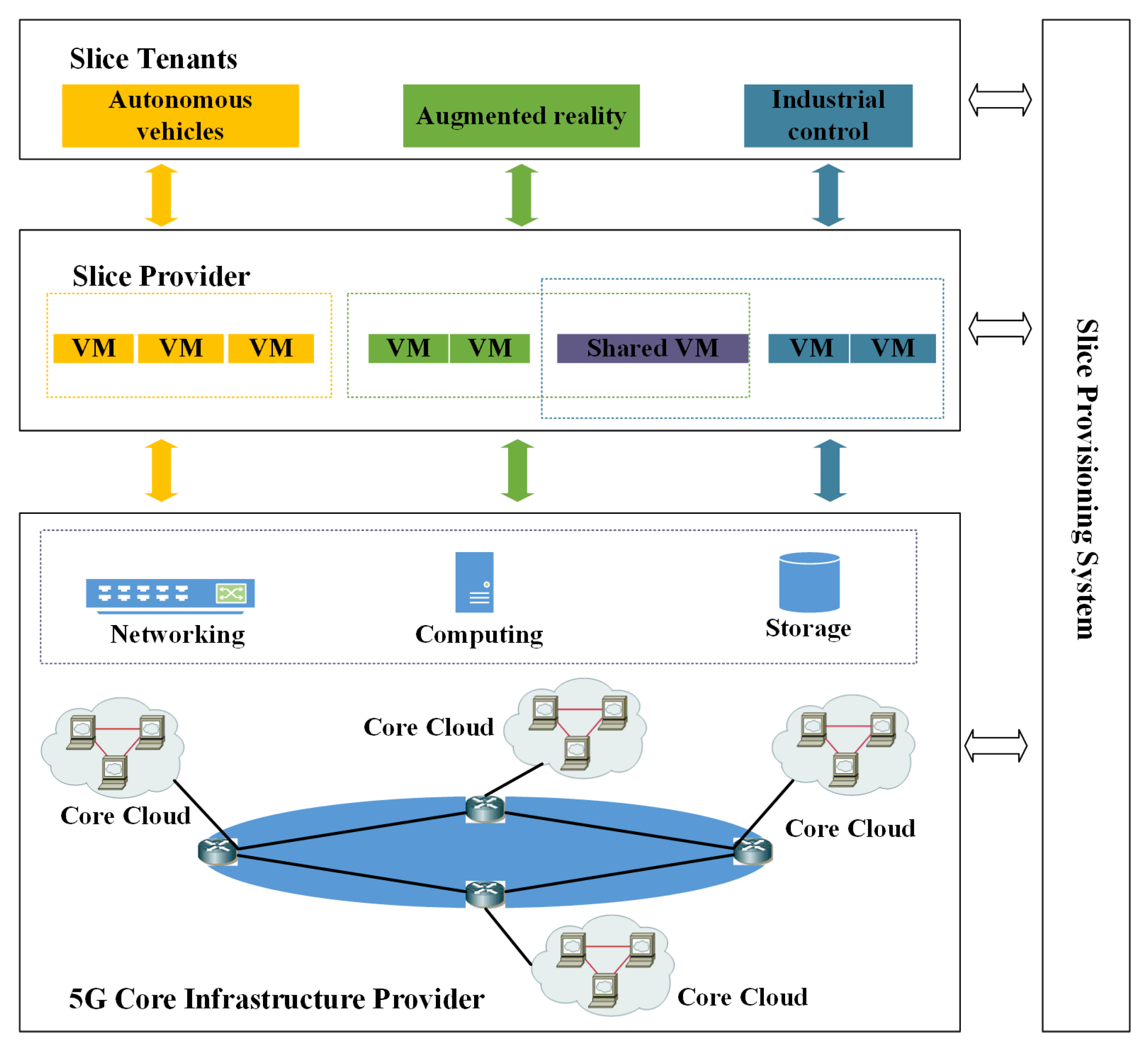

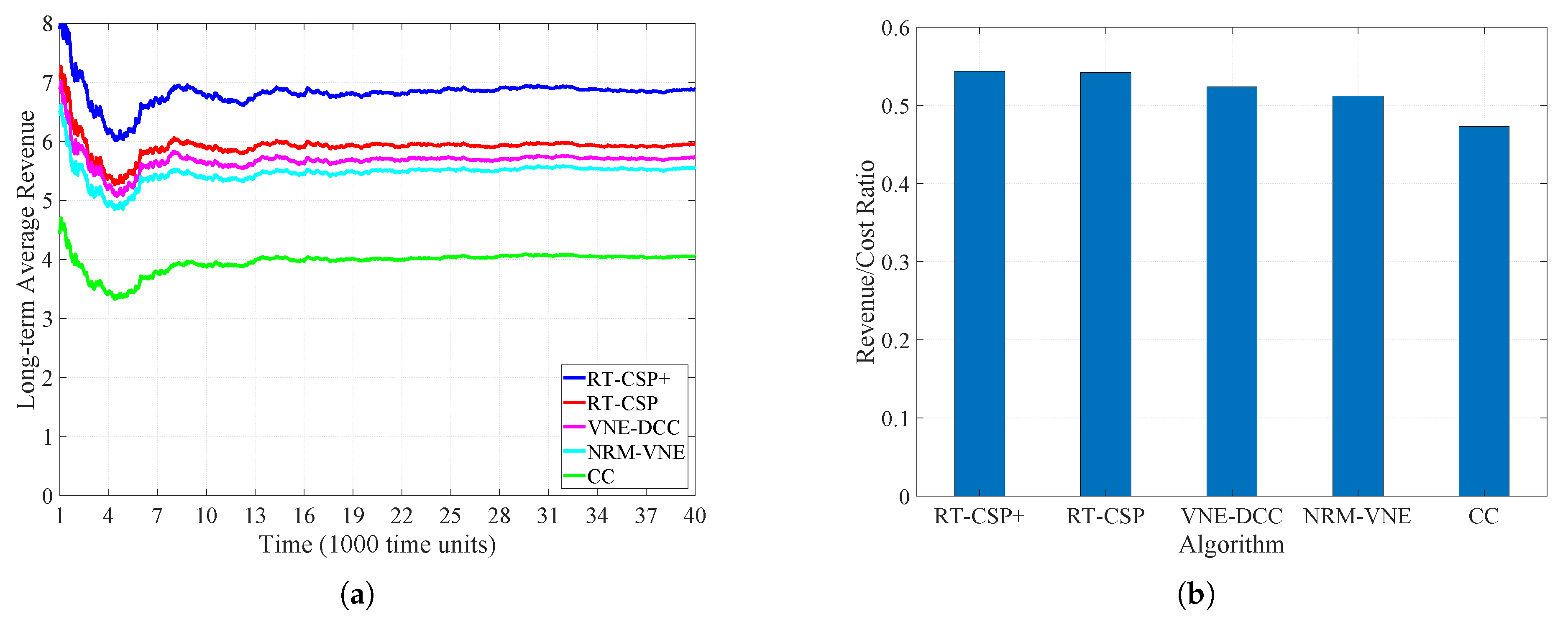
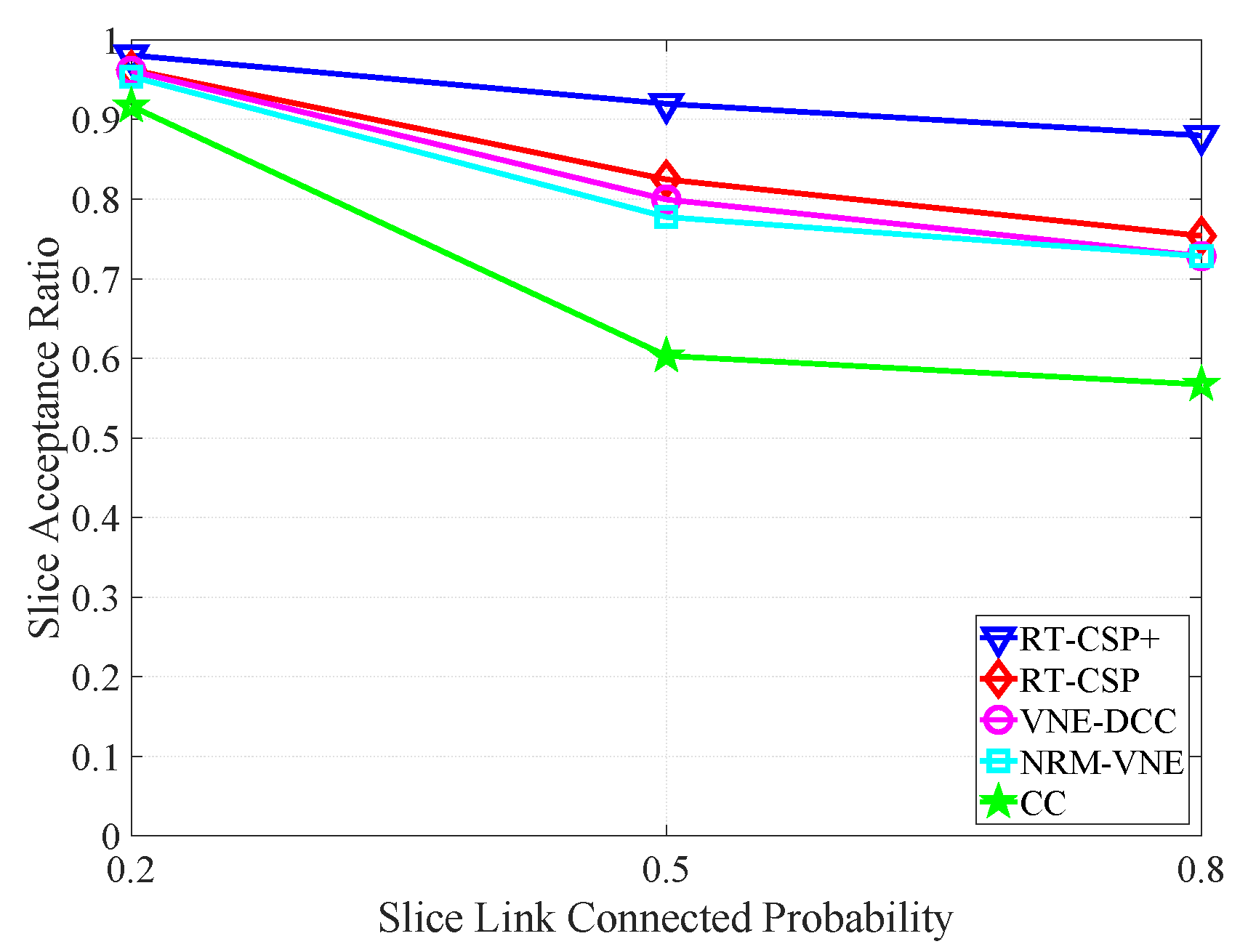

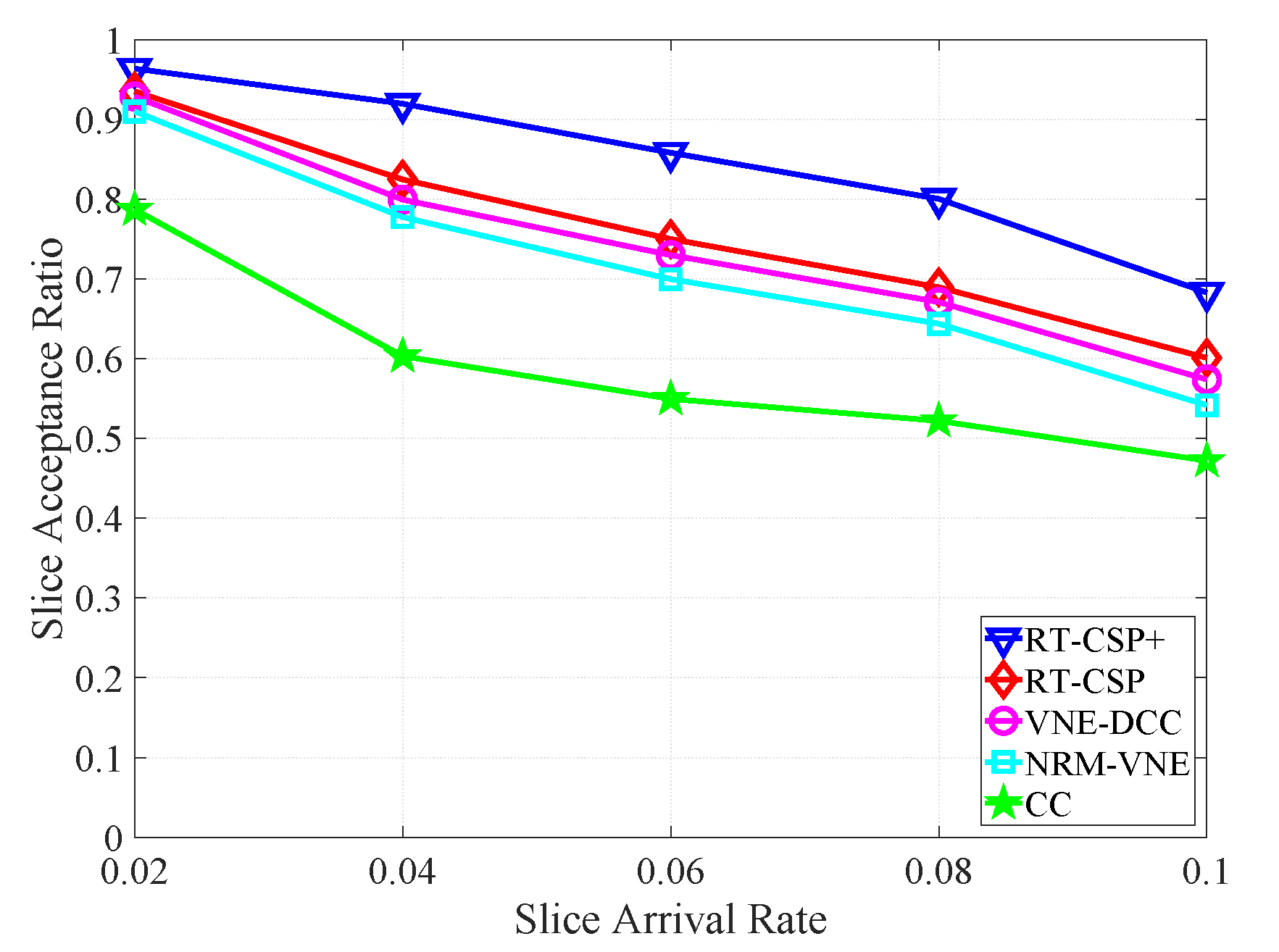
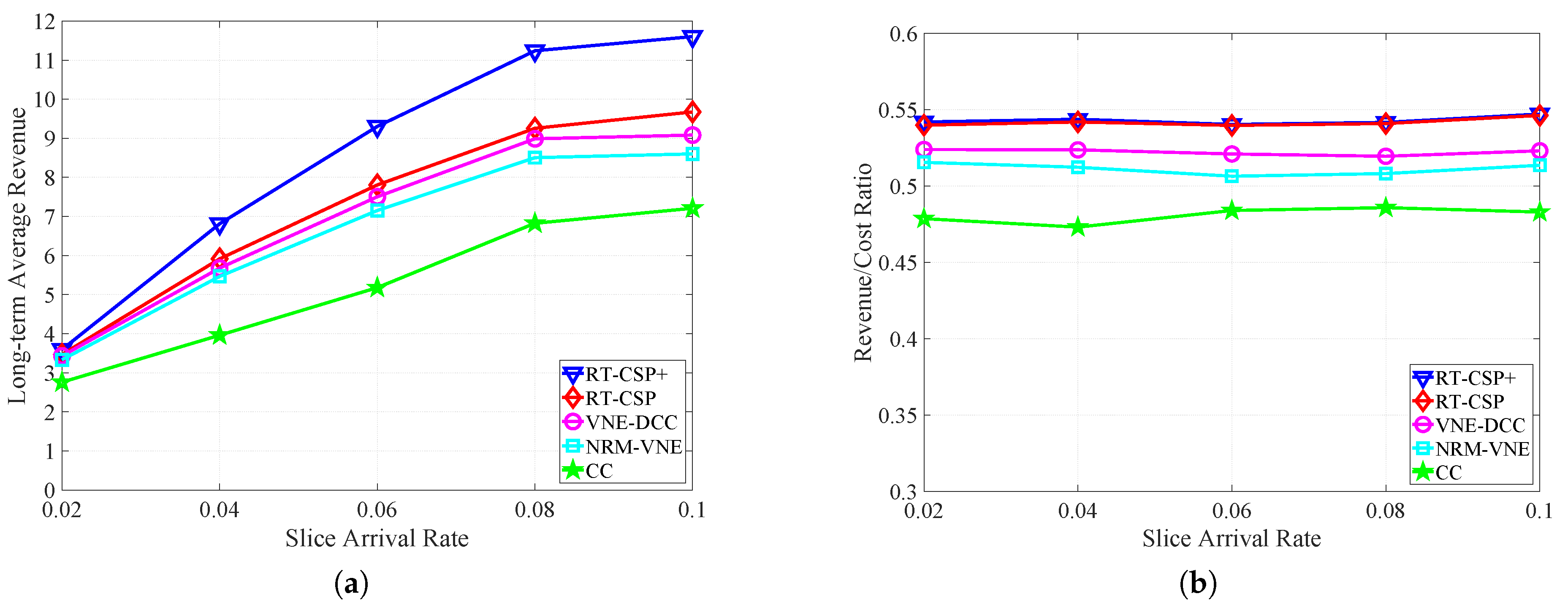
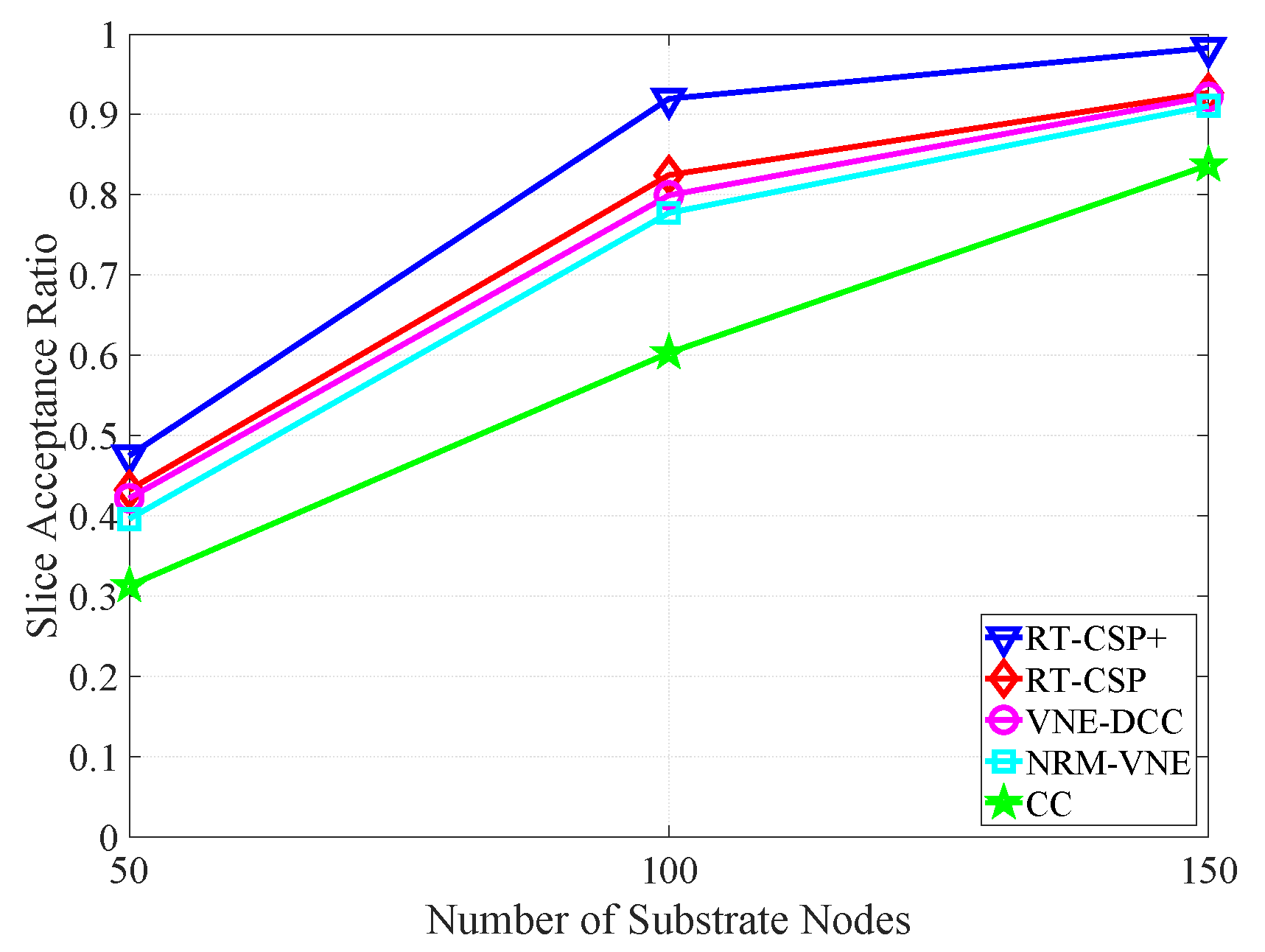
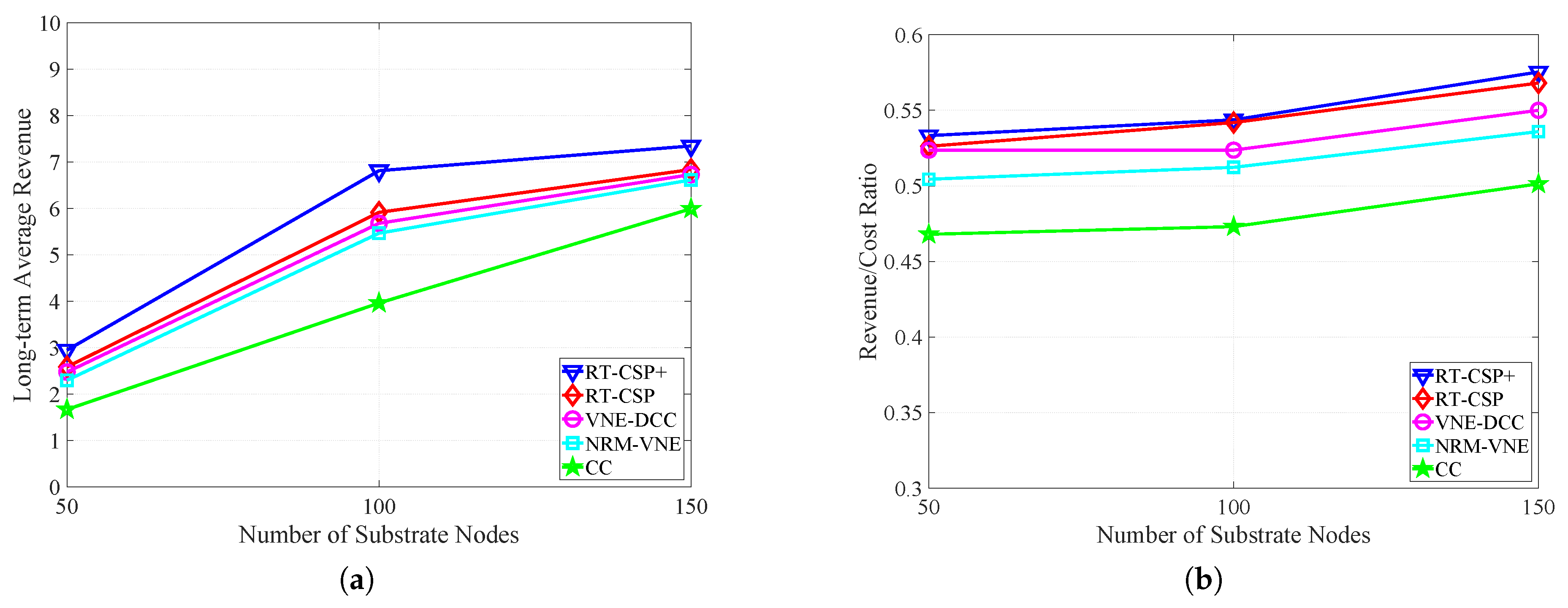
| Notation | Description |
|---|---|
| 5G core infrastructure topological graph. | |
| Set of physical nodes. | |
| Set of physical links. | |
| Initial total CPU capacity of physical node . | |
| Available CPU capacity of physical node . | |
| Total CPU capacity of physical node allocated to slice nodes. | |
| Location of physical node . | |
| Euclidean distance between physical nodes and . | |
| Initial total bandwidth of physical link . | |
| Available bandwidth of physical link . | |
| Total bandwidth of physical link allocated to slice links. | |
| Set of loop-free physical paths between and . | |
| Set of links in . | |
| 5G core network slice request topological graph. | |
| Set of slice nodes. | |
| Set of slice links. | |
| CPU capability required by slice node . | |
| Expected deployed location of slice node . | |
| Maximum deployed deviation allowed by slice node . | |
| Bandwidth required by slice link . |
| Parameter | Description |
|---|---|
| Number of substrate nodes | 50/100/150 |
| Probability of connecting substrate nodes | |
| Substrate node CPU | |
| Substrate link bandwidth | |
| Lifetime of slice requests obeying Exponential distribution | 500 time units in average |
| Number of slice requests | 2000 |
| Number of slice nodes in each slice | |
| Probability of connecting slice nodes | // |
| Slice node CPU demand | |
| Slice link bandwidth demand |
| Notation | Description |
|---|---|
| RT-CSP+ | The provisioning algorithm considering resource and topology attributes with the minMaxBWUtilHops based slice link provisioning |
| RT-CSP | The provisioning algorithm considering resource and topology attributes with the basic k-shortest path-based slice link provisioning |
| VNE-DCC | The algorithm considering local resource and topology attributes in [33] |
| NRM-VNE | The algorithm only considering local resource attributes in [28] |
| CC | The provisioning algorithm in [21] considering classic closeness centrality |
© 2019 by the authors. Licensee MDPI, Basel, Switzerland. This article is an open access article distributed under the terms and conditions of the Creative Commons Attribution (CC BY) license (http://creativecommons.org/licenses/by/4.0/).
Share and Cite
Li, X.; Guo, C.; Xu, J.; Gupta, L.; Jain, R. Towards Efficiently Provisioning 5G Core Network Slice Based on Resource and Topology Attributes. Appl. Sci. 2019, 9, 4361. https://doi.org/10.3390/app9204361
Li X, Guo C, Xu J, Gupta L, Jain R. Towards Efficiently Provisioning 5G Core Network Slice Based on Resource and Topology Attributes. Applied Sciences. 2019; 9(20):4361. https://doi.org/10.3390/app9204361
Chicago/Turabian StyleLi, Xin, Chengcheng Guo, Jun Xu, Lav Gupta, and Raj Jain. 2019. "Towards Efficiently Provisioning 5G Core Network Slice Based on Resource and Topology Attributes" Applied Sciences 9, no. 20: 4361. https://doi.org/10.3390/app9204361
APA StyleLi, X., Guo, C., Xu, J., Gupta, L., & Jain, R. (2019). Towards Efficiently Provisioning 5G Core Network Slice Based on Resource and Topology Attributes. Applied Sciences, 9(20), 4361. https://doi.org/10.3390/app9204361





